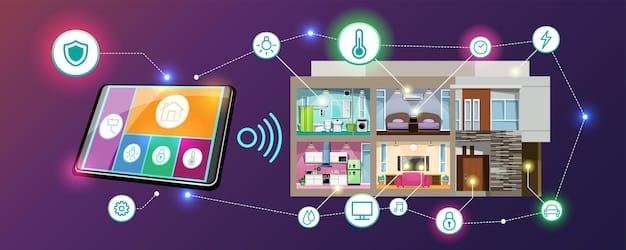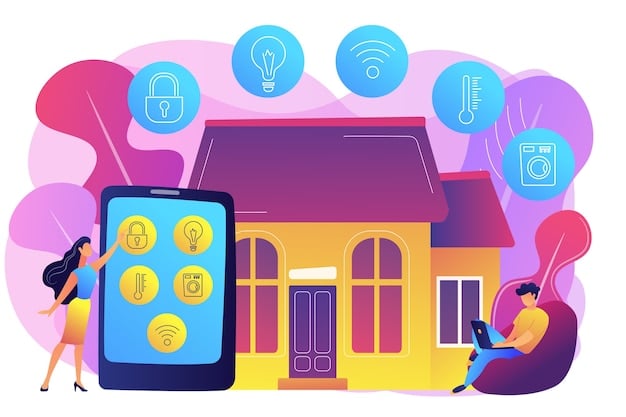Cybersecurity Alert: New Threat Exploits US Smart Home Devices

A new cybersecurity threat is targeting US smart home devices, exploiting vulnerabilities that can compromise user privacy and security, highlighting the urgent need for vigilance and robust security measures.
A new cybersecurity threat exploits weaknesses in US smart home devices, posing a significant risk to both individual privacy and broader network security. Discover how to protect yourself and your connected devices from these vulnerabilities.
Understanding the Emerging Threat Landscape for Smart Homes
The proliferation of smart home devices in the United States has brought convenience and efficiency to everyday living. However, this increased connectivity has also expanded the attack surface for cybercriminals. Understanding how these threats operate is the first step in mitigating risks and protecting your digital life.
Recent reports indicate a surge in cyberattacks specifically targeting vulnerabilities in smart home ecosystems. These attacks range from data breaches and privacy violations to more disruptive actions like ransomware and remote control of devices.
Common Vulnerabilities in Smart Home Devices
Smart home devices often have weak security protocols and outdated software, making them easy targets for exploitation.
- Weak Passwords: Many users fail to change default passwords, leaving devices vulnerable to brute-force attacks.
- Unencrypted Data: Data transmitted between devices and cloud servers may not be properly encrypted, allowing eavesdropping.
- Outdated Firmware: Manufacturers may not provide regular updates to patch security flaws, leaving known vulnerabilities unaddressed.
The Impact of a Compromised Smart Home
When a smart home device is compromised, the consequences can be far-reaching, affecting not only the device itself but also the entire home network.
- Privacy Invasion: Hackers can access cameras and microphones, monitoring activities within the home.
- Data Theft: Personal information, such as banking details and passwords, can be stolen from connected devices.
- Denial of Service: Attackers can disrupt services by disabling devices or flooding the network with traffic.
In conclusion, the expanding landscape of smart home devices brings significant convenience but also introduces new cybersecurity challenges. Understanding these threats and vulnerabilities is essential for homeowners to protect their digital lives and ensure the security of their connected devices.

Identifying Vulnerable Smart Home Devices
Not all smart home devices are created equal when it comes to security. Identifying which devices are most vulnerable is crucial for homeowners looking to fortify their digital defenses. Factors like manufacturer reputation, security certifications, and the frequency of firmware updates play a significant role in determining a device’s overall security posture.
Certain types of smart home devices tend to be more vulnerable than others due to their functionality and the data they collect.
Key Device Categories and Their Risks
Different types of smart home devices present unique security risks that users should be aware of.
- Security Cameras: Hackers can exploit vulnerabilities to access live feeds and recordings, compromising privacy.
- Smart Locks: If compromised, smart locks can allow unauthorized access to the home.
- Voice Assistants: Voice assistants can record and store conversations, raising privacy concerns and potential data breaches.
Assessing Device Security Before Purchase
Before buying a smart home device, it’s important to consider its security features and the manufacturer’s track record regarding security updates.
- Research the Manufacturer: Look for reputable brands known for prioritizing security.
- Check Security Certifications: Devices with certifications like UL or CSA often have undergone rigorous testing.
- Read User Reviews: Look for reviews that mention security concerns or vulnerabilities.
In conclusion, identifying vulnerable smart home devices requires careful evaluation of device categories, manufacturer reputation, and security features. By taking these factors into account before purchasing new devices, homeowners can significantly reduce their risk of falling victim to cyberattacks.
Protecting Your Smart Home Network
Once you’ve identified potential vulnerabilities, the next step is to implement robust security measures to protect your smart home network. This involves securing your Wi-Fi router, implementing strong passwords, and keeping your devices updated with the latest security patches.
Securing your home network is a foundational step in creating a safe and protected digital environment for your smart home devices. A strong network, when coupled with vigilant security practices, creates a formidable protection against cyber threats.
Securing Your Wi-Fi Router
Your Wi-Fi router is the gateway to your home network, making it a prime target for hackers. Securing it is essential for protecting your smart home devices.
- Change Default Credentials: Always change the default username and password.
- Enable WPA3 Encryption: Use the latest encryption standard for stronger security.
- Disable Remote Access: Unless necessary, disable remote access to prevent unauthorized access from outside your network.
Implementing Strong Passwords
Strong, unique passwords are a critical defense against unauthorized access to your smart home devices. Using the same password across multiple devices makes your entire ecosystem vulnerable.
- Use a Password Manager: Password managers can generate and store strong, unique passwords for each device.
- Enable Two-Factor Authentication (2FA): 2FA adds an extra layer of security, requiring a second verification method in addition to your password.
- Regularly Update Passwords: Change your passwords periodically to mitigate the risk of compromised credentials.
Utilizing Network Segmentation
Network segmentation involves dividing the network into smaller, more isolated segments. This limits the damage an attacker can inflict if a device is compromised.
- Guest Network: Use a guest network for visitors to prevent them from accessing your primary network.
- Dedicated IoT Network: Create a separate network specifically for your smart home devices.
In conclusion, there are multiple strategies homeowners can use to secure their smart home network. These strategies—including Wi-Fi security, password implementation, and network segmentation—can work in concert to greatly strengthen your digital defenses.

Privacy Best Practices for Smart Home Users
In addition to securing your network and devices, it’s important to adopt privacy best practices to protect your personal information. This includes reviewing privacy settings, disabling unnecessary features, and being mindful of the data you share with smart home devices.
Privacy is a critical component of smart home security. Safeguarding personal information and ensuring your data is protected from unauthorized access is paramount.
Reviewing Privacy Settings
Smart home devices often collect a wealth of personal information. Reviewing and adjusting privacy settings can limit the amount of data collected and shared.
- Disable Data Collection: Opt out of data collection whenever possible to limit the amount of information shared with the manufacturer.
- Adjust Camera Settings: Adjust camera settings to limit recording to specific times or areas.
- Review Voice Assistant History: Regularly review and delete voice recordings stored by voice assistants.
Limiting Data Sharing
Be mindful of the data you share with smart home devices and third-party services. Limit the amount of personal information you provide and avoid sharing sensitive data when possible.
- Read Privacy Policies: Understand how your data is collected, used, and shared by the manufacturer.
- Use End-to-End Encryption: Choose devices that support end-to-end encryption to protect your data.
- Avoid Linking Accounts: Be cautious when linking smart home devices with other online accounts.
Regular Audits and Assessments
Performing routine checks and assessments of the security and privacy settings of your smart home devices is an important best practice.
- Audit Device Permissions: Make sure devices only have necessary permissions.
- Assess Data Usage: Monitor which devices are using the most data and investigate any anomalies.
In conclusion, smart home users can significantly enhance their privacy by actively managing settings, limiting data sharing, and performing regular audits. These steps empower users to maintain greater control over their personal data.
Responding to Security Incidents
Despite your best efforts, security incidents can still occur. Knowing how to respond quickly and effectively can minimize the damage and prevent further compromises.
Having a plan in place, understanding incident response steps and reporting any suspicious behavior could be the difference between a minor setback and a disastrous breach.
Immediate Actions to Take
If you suspect a security incident, take immediate action to contain the damage and prevent unauthorized access.
- Disconnect the Device: Immediately disconnect the compromised device from the network to prevent it from spreading the infection.
- Change Passwords: Change passwords for all accounts associated with the device.
- Run a Malware Scan: Perform a malware scan on your network to identify and remove any malicious software.
Reporting Security Breaches
Reporting security breaches to the appropriate authorities can help prevent future attacks and protect other users.
- Contact the Manufacturer: Report the incident to the device manufacturer to alert them to potential vulnerabilities.
- File a Report with the FTC: File a report with the Federal Trade Commission (FTC) to alert them to consumer fraud and security breaches.
- Notify Law Enforcement: In cases of identity theft or financial fraud, notify local law enforcement.
Creating an Incident Response Plan
A well-defined incident response plan can streamline your reaction to security breaches, ensuring that critical steps are not overlooked.
- Identify Key Contacts: List contacts for reporting and addressing security issues.
- Detail Response Procedures: Outline step-by-step procedures to follow during a security incident.
- Regularly Update the Plan: Keep the response plan updated to address new threats and vulnerabilities.
In conclusion, prompt and well-coordinated actions can greatly mitigate the impact when responding to security incidents. Whether it is disconnecting a device, reporting a breach, or implementing a pre-set incident response plan, each action helps to protect yourself and others in the smart home community.
The Future of Smart Home Security
As smart home technology continues to evolve, so too will the threats and challenges associated with it. Staying informed about emerging security trends and adopting proactive measures is essential for protecting your smart home in the years to come.
The landscape of smart home technology looks to include greater integration, heightened awareness of security protocols on the part of the consumer, and ongoing advancements in device security.
Emerging Security Technologies
New security technologies are constantly being developed to address the evolving threats to smart home devices.
- AI-Powered Security: Artificial intelligence (AI) can detect and respond to threats in real time.
- Blockchain Technology: Blockchain can enhance security and privacy by providing a secure and transparent ledger of device activity.
The Role of Industry Standards
Industry standards and certifications play a critical role in ensuring the security of smart home devices. Look for devices that comply with recognized standards and certifications.
- Matter Standard: The Matter standard aims to create a unified and secure smart home ecosystem.
- Security Certifications: Certifications like UL and CSA demonstrate that a device has undergone rigorous security testing.
Consumer Responsibility and Education
Ultimately, the responsibility for securing a smart home rests with the consumer. Staying informed and adopting proactive security measures is essential for protecting your digital life.
- Stay Informed: Keep up to date on the latest security threats and best practices.
- Educate Yourself: Take advantage of online resources and training to learn more about smart home security.
In conclusion, the future of smart home security depends on the adoption of new technologies, adherence to industry standards, and above all, an informed and responsible consumer base. As technology evolves, so too must our commitment to securing our smart homes.
| Key Point | Brief Description |
|---|---|
| 🚨 Emerging Threats | Smart homes face rising cyber threats. |
| 🛡️ Protection Measures | Secure Wi-Fi, strong passwords, and updates. |
| 🔒 Privacy Practices | Review settings and limit data sharing. |
| 🚨 Incident Response | Disconnect, report, and have a plan. |
Frequently Asked Questions
▼
Smart home devices are often vulnerable due to weak default passwords, unencrypted data transmission, and infrequent security updates from manufacturers, leaving them open to cyber threats.
▼
To secure your Wi-Fi router, change the default credentials, enable WPA3 encryption, and disable remote access. Regularly update the router’s firmware to patch any security vulnerabilities.
▼
Two-factor authentication (2FA) adds an extra layer of security by requiring a second verification method, such as a code sent to your phone, in addition to your password when logging in.
▼
Network segmentation divides your network into smaller, isolated segments, limiting the damage an attacker can inflict if one device is compromised. This helps prevent the spread of an infection.
▼
If you suspect a security breach, immediately disconnect the compromised device, change passwords for all associated accounts, and run a malware scan on your network to identify and remove any malicious software.
Conclusion
In conclusion, safeguarding US smart home devices from emerging cybersecurity threats requires a multifaceted approach. By understanding vulnerabilities, implementing robust security measures, practicing privacy best practices, and staying informed, homeowners can create a secure and protected digital environment.





